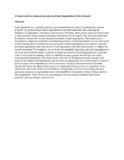/ library resources
Showing items 1 through 9 of 13.Land degradation is a gradual, negative environmental process that is accelerated by human activities. Its gradual nature allows degradation to
proceed unnoticed, thus reducing the likelihood of appropriate and timely control action. Presently, there are few practical frameworks to help
Most of our semi-arid land is threatened with increased land deterioration due to
changes in land use especially in areas where soils have sealing properties which
hinder infiltration of rain- water. The study was carried out in Kibwezi Division,
Most early alley cropping studies in semi-arid Kenya were on fairly flat land while there is an increase in cultivated sloping land. The effectiveness of aging contour hedgerows and grass strips for erosion control on an about 15% slope of an Alfisol was compared.
Kenya’s land surface is primarily arid and semi-arid lands (ASALs) which account for 84% of the total land area.
Rehabilitating degraded rangelands using enclosures offers various benefits to agro-pastoral households. However, enclosure benefits cannot be generalized as there are variations across dryland ecosystems and societies.
The study discusses land-degradation in pastoral communities and depicts land-use system and associated human and livestock population pressure as the major determinant of vegetation cover, surface run-off, soil erosion, and species richness.
Land degradation is a major problem in the semi-arid environments of Sub-Saharan Africa. Fighting land degradation is essential to ensure the sustainable and long-term productivity of the habited semiarid lands. In Kenya, grass reseeding technology has been used to combat land degradation.
Livestock production is the main source of livelihood in the arid and semi-arid lands in Africa. However, desertification characterized by vegetation degradation and soil erosion is a major threat to the sustainability of land-based production systems.
Pagination
Land Library Search
Through our robust search engine, you can search for any item of the over 73,000 highly curated resources in the Land Library.
If you would like to find an overview of what is possible, feel free to peruse the Search Guide.








